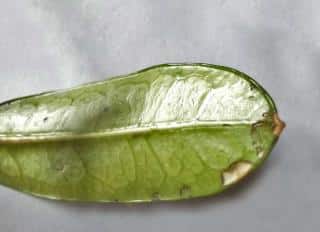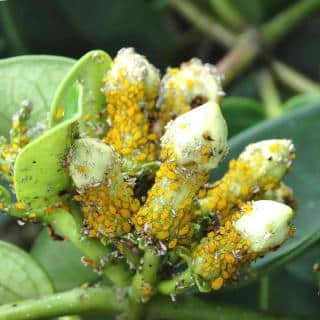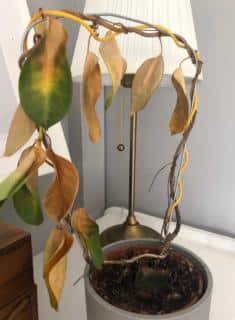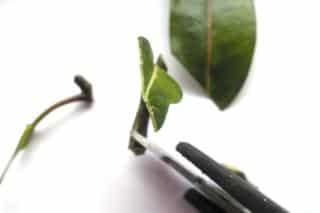

Stephanotis often falls sick because of diseases and pests.
This mostly happens at the beginning: in time, you’ll strike the perfect balance between water, sun and fertilizer and your plant will resist all these problems!
This beautiful and deliciously fragrant vine is a little more difficult to care for than other houseplants.
But keeping it pest and disease-free is well worth the effort with its beautiful fragrant blooms!
If a cottony white substance starts covering your stephanotis leaves, a scale insect colony has appeared. Occasionally, “armored scale” appears: these have a shell which they glue to the leaves (example of armored scale on this ZZ plant).
 Thrips are colonizing your stephanotis.
Thrips are colonizing your stephanotis.
Stephanotis can also be colonized by mites and ticks such as red spider mites, especially when the surrounding air is too dry.
 Aphids is most certainly what you’re dealing with.
Aphids is most certainly what you’re dealing with.
Several aphid varieties have Madagascar jasmine as one of their host plants.
Leaves turn yellow on a stephanotis plant for either of three reasons: overwatering, the water used for watering is too hard, or the plant lacks light.
 Too much water leads to plant root rot. Fungus such as phytophthora infect the plant and kill it. Symptoms? Leaves turn soft and floppy, then start turning yellow, usually from the stem outwards.
Too much water leads to plant root rot. Fungus such as phytophthora infect the plant and kill it. Symptoms? Leaves turn soft and floppy, then start turning yellow, usually from the stem outwards.
You can try to recover the plant by
These tips will help surviving portions of the plant get healthier. From there, train the growth again to replace what has died off.
If you use tapwater to water, perhaps it’s too hard.
If you only have tap water, then prepare it with the following steps:
Light must be plentiful but not direct. Indeed, in the wild, Stephanotis is a vine that climbs up trees and such. It rarely gets direct light, at most for a half-hour or so as the sun shines through the shade.
Is your Stephanotis not flowering? This happens when the plant isn’t yet in an ideal growing environment. It’s a very picky plant.
Try the following:
 Mist the leaves or rest the pot atop a tray with clay pebbles doused in water. Consider other ways to increase air moisture.
Mist the leaves or rest the pot atop a tray with clay pebbles doused in water. Consider other ways to increase air moisture.When bought from a nursery, blooming Stephanotis will often drop their flowers in a matter of weeks. They then need a long time to recover and adjust to their new growing environment. This is normal, and you’ll have to be patient! Don’t lose hope, however. As long as the plant looks healthy and is producing new growth, then it’ll come around and flower again.
Your comment is awaiting moderation.
What is the big fruit like on my stephanotis? Looks like a big mango fruit hanging from the vine.
It’s exactly as you think – a stephanotis seed pod! Inside are many seeds with a fluffy tail to fly away. When it dries out, seeds will spread and germinate immediately if they meet moist soil. Learn more about it here.
My Stephenotis has large marbling on it leaves.
Hi Pamela, it seems it might be some type of fungus. These usually start attacking when the plant is weak, for instance when it’s particularly hot or when it lacks water or nutrients.